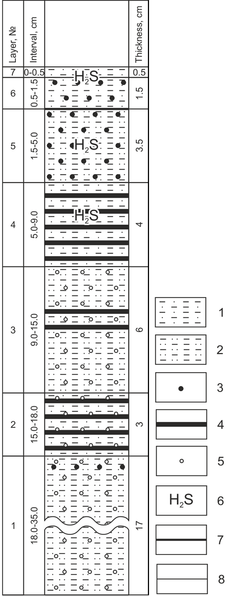RUSSIAN JOURNAL OF EARTH SCIENCES, VOL. 18, ES6003, doi:10.2205/2018ES000639, 2018

Figure 2. Lithological characteristics of bottom sediments of the South Caspian Basin (Station 3916): 1) – pelite with silty impurity; 2) – pelite with sandy and silty impurity; 3) – inclusion of hydrotroilite; 4) – hydrotroilite layers; 5) – porous-cavernous texture; 6) – hydrogen sulphide; 7) – distinct boundary; 8) – gradational contact. Layer 7. Pelitic ooze with silty impurity, highly water-saturated ("fluffy-layer"), represented by flakes of black and greenish-gray color of 2–5 mm in size, with a strong smell of hydrogen sulfide. Layer 6. Pelitic ooze with silty impurity, slightly calcareous, is greenish-brown in color with numerous inclusions of black hydrotroilite, with the smell of hydrogen sulfide. Layer 5. Pelitic ooze with sandy and silty impurity, greenish-gray color. The degree of calcareousness varies from bottom to top along the section: from calcareous in the lower part of the layer to slightly calcareous at the upper contact. Spherical hydrotroilitic bundles with a diameter of not more than 1 mm are present at levels of 2.5, 3.5 and 4.5 cm. There is a smell of hydrogen sulfide. Layer 4. Pelitic ooze with silty impurity, calcareous, grayish-green color. The texture is micro-layered in the form of a clear interlayering of layers of pelitic ooze grayish-green (2 mm thick) and black hydrotroilite layers (1 mm thick). In the interval from 5 to 8 cm there is a smell of hydrogen sulfide. Layer 3. Pelitic ooze with sandy and silty impurity, slightly calcareous to calcareous, light gray. Hydrotroilite microlayers are in the interval of 11–12 cm. Caverns of irregular or rounded shape no larger than 5 mm appear in the interval of 11-15 cm. Layer 2. Pelitic ooze with silty impurity, slightly calcareous, gray. The texture is micro-layered in the form of a clear interlayering of thin layers of gray pelitic ooze (up to 2 mm thick) and black hydrotroilite layers (up to 1 mm thick). There are pores and caverns. Layer 1. Pelitic ooze with sandy and silty impurity, calcareous in the lower part of the layer, slightly calcareous in the upper part of the layer, light gray, chalk-like color, with black hydrotroilite inclusions. Spherical hydrotroilite bundles with a diameter of less than 1 mm are in the interval of 19–20 cm. The texture is porous-cavernous.
Citation: Kozina N., L. Reykhard, O. Dara, V. Gordeev (2018), Framboidal pyrite formation in the bottom sediments of the South Caspian Basin under conditions of hydrogen sulfide contamination, Russ. J. Earth Sci., 18, ES6003, doi:10.2205/2018ES000639.
Copyright 2018 by the Geophysical Center RAS.
Generated from LaTeX source by ELXpaper, v.1.5 software package.

